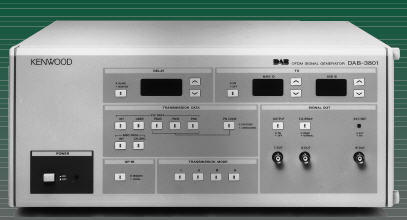DAB3801 OFDM (DAB) Signal Generator
DAB-3801 is a test signal generator conformable to the European DAB (Digital Audio Broadcast) Standard ETS 300 401.

Features
-
Complies with DAB transmission modes I, II, III and IV
-
Outputs Quasi-random codes for measuring the bit error rate BER, which is needed to evaluate the receiver performances.
-
If several DAB-3801 units are connected, they can generate the same test signals with a time lag, enabling SFN (single frequency network) verification.
-
Has random access FIC memory for verification of any receiver systems which the user wants.
-
An internal backup circuit maintains FIC and panel setting written in the memory for four days at least.
-
Outputs the pre-determined MSC multiplex configuration information (MCI), broadcasting station name (LABEL), program type (PTY), etc. repeatedly as the fixed FIC data.
-
Internally replaceable I and Q signals allow the user to reverse the spectrum with a single switch when IF loop-back verification is changed into RF loop-back verification.
-
A built-in asynchronous sampling rate converter receives digital output signals from a CD, MD or DAT player.SPECIFICATIONS
Signal Format]
Compliant with the ETS 300 401 DAB system.
[Reference Oscillator]
Frequency 24.576MHz Stability ¡Ó3ppm
[Setting Ranges]
Modes and Setting Ranges
| Transmission mode |
Delay time |
Main ID |
Sub ID |
Pseudo random code |
Intermediate freq. |
|---|---|---|---|---|---|
I |
0 to 400 |
0 to 69 |
0 to 23 |
PN9, PN15, PN23 (CCITT conformable) |
38.912MHz (See Specifications of IF Block.) |
II |
0 to 100 |
0 to 69 |
0 to 23 |
||
III |
0 to 50 |
0 to 5 |
0 to 23 |
||
IV |
0 to 200 |
0 to 69 |
0 to 23 |
Note: The delay time is specified in units of 1/1.024MHz.
[Specifications of Basic MSC Data]
Specifications of Basic MSC Data
Sub Channel |
Bit rate |
Audio mode |
Audio data(L) |
Audio data(R) |
Protection Level |
Code rate |
size |
Start Address |
1 |
256kb/s |
stereo |
1kHz 0dB |
1kHz 0dB |
4 |
R¡Ü0.6 |
168CUs |
0 |
2 |
224kb/s |
stereo |
1kHz 0dB |
MUTE |
3 |
R¡Ü0.5 |
168CUs |
168 |
3 |
224kb/s |
stereo |
MUTE |
1kHz 0dB |
4 |
R¡Ü 0.6 |
140CUs |
336 |
4 |
192kb/s |
stereo |
1kHz 0dB |
2kHz 0dB |
3 |
R¡Ü0.5 |
140CUs |
476 |
5 |
192kb/s |
stereo |
4kHz 0dB |
4kHz 0dB |
4 |
R¡Ü0.6 |
116CUs |
616 |
6 |
64kb/s |
mono |
1kHz 0dB |
1kHz 0dB |
3 |
R¡Ü0.5 |
48CUs |
732 |
7 |
64kb/s |
3 |
R=0.5 |
48CUs |
780 |
|||
8 |
24kb/s |
2 |
R=0.375 |
24CUs |
828 |
|||
9 |
32kb/s |
no coding |
........ |
12CUs |
852 |
*Internally generated PN codes are output as data through sub-channels 7, 8 and 9. *FIC does not contain the multiplex information carried through sub-channel 9.
[Specifications of OFDM Modulator Block]
Modulation Type Specifications
OFDM SIGNAL GENERATOR
| MODE I |
MODE II |
MODE III |
MODE IV |
|
|---|---|---|---|---|
Modulation type |
OFDM (£k/4-QPSK) |
|||
Number of OFDM symbols (L) |
76 |
76 |
153 |
76 |
Number of carriers (K) |
1,536 |
384 |
192 |
768 |
Frame Length (TF) |
96ms |
24ms |
24ms |
48ms |
Modulated wave output sampling rate |
4.096M Sample/sec |
|||
Modulated wave bandwidth |
¡Ó768kHz |
|||
Products list | brand | Model No. | Home